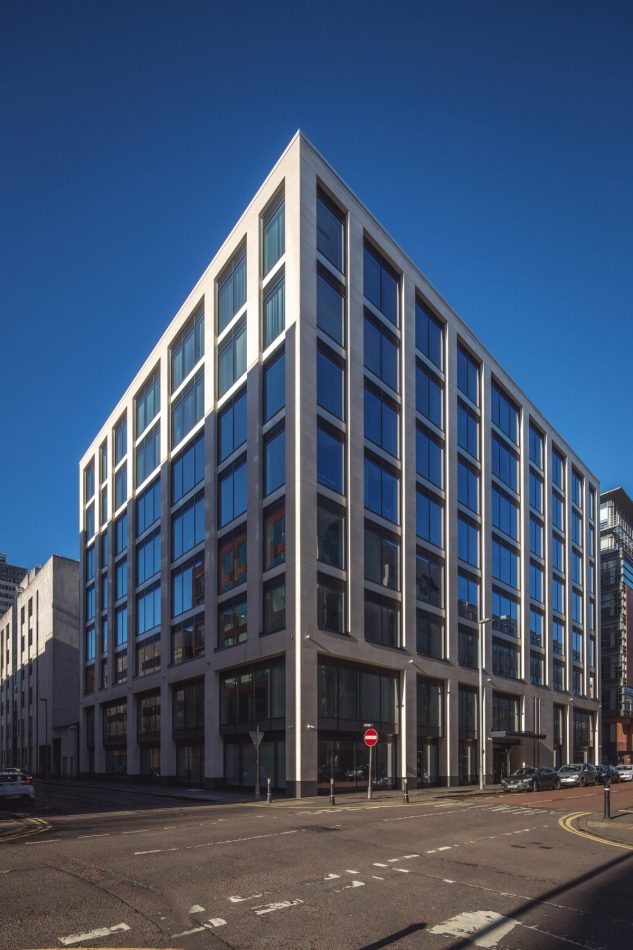McAleer & Rushe’s first BIM project embraced software to overcome a tight schedule, design delays and complex works to set a high standard of planning excellence and delivery
The tight programming and communications during the construction of 9 Adelaide for client Belfast City Council was instrumental in helping McAleer & Rushe deliver its first BIM project not just on time, but early – despite design delays which required the company to make up four months and complex connections with the existing council building next door.
This 18-month project saw the demolition of a 10-storey block and construction of a new 100,000 sq ft net internal area (9,300 sq m) office building in its place.
Project manager Margaret Conway has been a Powerproject user for 10 years, and it is McAleer & Rushe’s standard planning solution. She used the software to balance progress against programme, maintaining solo control over the programme and progress reporting throughout.
 Fitout first
Fitout first
Conway produced the master programme at pre-contract stage and, when starting on site, developed more detailed programmes for the frame, envelope and internal fit-out elements using Powerproject.
When diving into the detail, some concern arose about the original methodology and critical path. The project had two sectional handover dates because the client needed two floors completed ahead of the full project. Enabling this meant finding a way to bring fit-out works forward – yet curtain walling was to be installed on an elevational basis, and would not be complete until late in the programme.
Conway explained: “I looked at splitting the fitout into two zones, on each floor, with the central areas being completed independent of, and ahead of, the outer works. I used Powerproject to explore whether we could then do all the fitout work for the first sectional handover.”
Collaborative communication
As a BIM project, managing work demanded strong collaboration between the main contractor, consultants and subcontractors.
“Success depends not just on getting your programme across to every subcontractor but getting them to sign up to it,” said Conway.
“I was able to use Powerproject code libraries to filter out each subcontractor programme, which was helpful as they could just see their own programme. It uncomplicated it, and was easy for them to understand.”
Tight oversight
Tight control was critical from the outset. Conway used Powerproject to design an Information Release Schedule to help the team stay ahead on design and procurement.
“Dates from the Information Release Schedule were plugged directly into the design and procurement schedule, and everything was worked back from the master programme,” she said.
“I closely monitored progress on site by producing four-weekly look-ahead reports in Powerproject, for both the internal and external elements. Weekly coordination meetings were held for both fit-out and façade works, and these programmes were reviewed at every meeting to ensure progress was maintained.”
Connected construction
 The new office building was located close to the client’s existing head office, creating additional factors to manage, including the need to construct a link bridge between the two to enable council staff to move between the buildings.
The new office building was located close to the client’s existing head office, creating additional factors to manage, including the need to construct a link bridge between the two to enable council staff to move between the buildings.
Conway said: “I used Powerproject to help communication with the client’s staff: to identify for them when we’d need access to the link bridge, let them know when we were doing investigation work, notify them when their fire escapes would close, and when they’d lose access to particular offices.”
Powerproject reports were used to help brief other internal departments, such as digital services, M&E and IT so that they could engage services at the right time, without impacting the programme.
Façade by façade
The software also added in Conway’s analysis to identify the least-cost choice for managing the façade work.
She said: “I produced a programme in Powerproject analysing mast climbers versus scaffold. Powerproject is very good for that sort of thing because you can quickly see where you can lose resources, such as a tower crane, work everything into the prelim, and know how much each route is going to cost.”
Looking forward
Ultimately, this tight project management approach paid dividends, not only meeting the first sectional handover date but with the main building handed over a full two months ahead of programme, on budget and with a flawless health and safety record. The relationship with the client was strengthened, and has already led to another contract award.
Powerproject helped to support excellent project management on this landmark project. Reflecting on the software itself, Conway concluded: “I don’t use any other project management programmes. Powerproject is easy to use, and there’s no reason to use anything else.
“Its greatest strength is as a communication tool, and getting everybody organised. When you’re having meetings, and have a programme there that specifically sets out who has to do what by when, it gets rid of any confusion. It clearly establishes everybody’s responsibilities and deadlines. It makes you think right from the start about how to construct the building and that forces you to recognise risks well in advance, so you can deal with them proactively.”
Elecosoft
Tel: +44 (0)1844 261 700
Twitter: @astapmsoftware














